About Us
Falcon Hunting Solutions mainly focuses on environmental protection, biodiversity preservation and trophy hunting development as an ecotourism segment of Uzbekistan. During its activities, the company has established relationships with both ministries and different organizations involved in the process of biodiversity conservation (cooperation agreements with the State Committee on Ecology and Environmental Protection, the State Committee on Forestryand the Institute of Zoology) and with foreign partners in order to conduct joint biotechnical activities aimed at preserving animals in the Red List of the Republic of Uzbekistan. Our company provides intensive technical assistance in studying an international experience in preserving and increasing the livestock of rare animals listed in the Red List of the Republic of Uzbekistan. We also aim to attract international experts to register and develop proposals for maintaining and increasing livestock of wild animals.
ECOTOURISM DEVELOPMENT
Ecotourism is a type of tourism, which involves traveling to untouched nature places in order to get an idea of the natural, cultural and ethnographic features of the area without any violation of the ecosystem integrity. It creates such economic conditions under which the protection of nature and natural resources becomes beneficial for the local population and satisfies the desire to communicate with the nature.In recent years, eco-tourism has become a major segment of tourism and a new area in the tourism industry. According to World Tourism Organization forecasts, it is among the five main strategic directions for the development of tourism until 2020 and it is estimated that the share of ecotourism in the total volume of the global tourism industry has reached more than 10% in recent years.
Nowadays Uzbekistan is one of the most popular ecotourism destinations in Central Asia.
Ecotourism development provides comprehensive support for the environmental protection system, the preservation of biodiversity and unique natural areas as well as the income maintenance of the local population thus it is a promising market for investment projects.
Uzbekistan has a lot of great opportunities for ecotourism promoting since it has favorable geographic location with unique network of protected natural areas and a rich variety of landscapes.
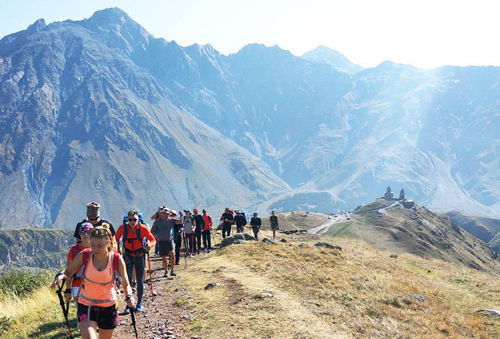

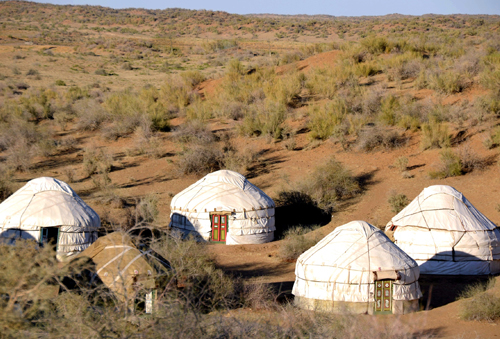
Wild animals reacclimatization
Reacclimatization is the resettlement of animals within the territories where they previously inhabited. This event is carried out in order to replenish the existing population of animals or its restoration. The issue of specific species of animals and places of their settlement (Bukhara deer, Tien Shan ram, etc.) is being considered.
The following activities are carried out to facilitate the wild animalsreacclimatization:
Release of young animals raised in nurseries to its natural habitat such as resettling Bukhara deer to the natural habitats of the Syrdarya river floodplain in the Tashkent region (Dalverzin farm) and also
Tien Shan ram which was imported from the Kyrgyz Republic and bred in the nursery:
* Adaptation activities for animals to new conditions.
* All animals released to the nature are marked with microchips or other non-removable marks.
* Monitoring the process of animals adaptation to new conditions.
* Carrying out biotechnical measures which are set of measures aimed at preserving, replenishing, increasing and reproducing animals, preserving the habitat, and increasing the productivity of land. Carrying out activities is an effective method of artificially maintaining the optimal number of wild animals.
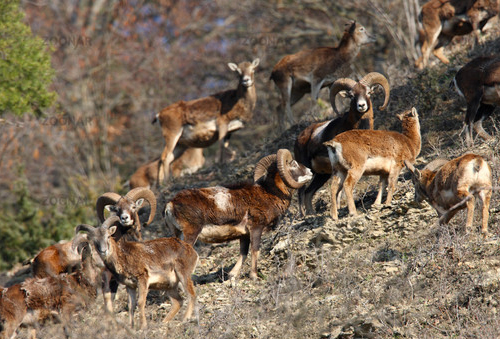
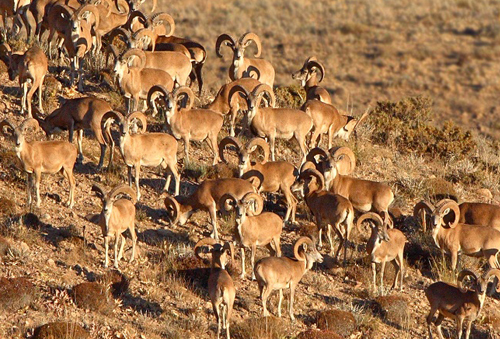

Environmental protection
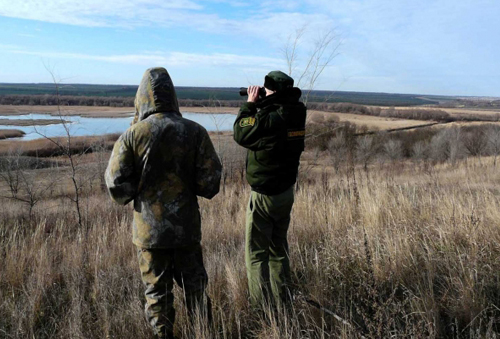 Environmental protection is a scientific set of measures for the conservation, rational use and restoration of natural resources and the natural environment, including the species diversity of flora and fauna, mineral resources richness, the water purity, forests and the Earth atmosphere
Environmental protection is a scientific set of measures for the conservation, rational use and restoration of natural resources and the natural environment, including the species diversity of flora and fauna, mineral resources richness, the water purity, forests and the Earth atmosphere
Environmental protection has an economic, historical, social, and governmental significance.
The concept of “environmental protection encompassesthe mankind’s habitat and activity, including not only the natural environment (natural objects), but also the anthropogenic environment (objects created by man in the process of its activity). Therefore, an environmental protection includes nature conservation as one of its components. At the same time, the focus of environmental protection is on the conservation of the biosphere and its constituent ecosystems (Biogeocenosis), and within the framework of environmental protection, the priority is given to meeting the ecological needs of humans, including maintaining favorable local and regional conditions for existence (e.g. in the urban environment)
Environmental protection is implemented due to special gamekeeper service, an authorized person or state inspectors from the State Committee of the Republic of Uzbekistan on ecology and environmental protection. Besides it can be done by a company’s forest and gamekeeper service in their assigned territories by conducting operational raids;
* Setting the fencing area;
* Establishment of the special signs.
* Forming the gamekeeper team
* Providing gamekeepers with civilian firearms and traumatic weapons, communications devices, vehicles and other equipment.
There is a ban on wild animals’ habitat disturbance, such as:
* Felling trees and shrubbery;
* Collecting fruits of wild plants;
* The livestock grazing ban.
Measures development for preservation and increase the number of wild animals (the hunting objects) is carried out in the following areas:
* Artificial (captive) or half-bred breeding (a large fenced area where animals live freely, move and feed mainly with natural food and live most of their lives without human intervention);
* Conducting biotechnical activities aimed at improving the habitat, the animals feeding, planting of fodder and protective vegetation, watering facilities and salt licks as well as protection of animals and their habitat;
Breedingof wild animals listed in Red List
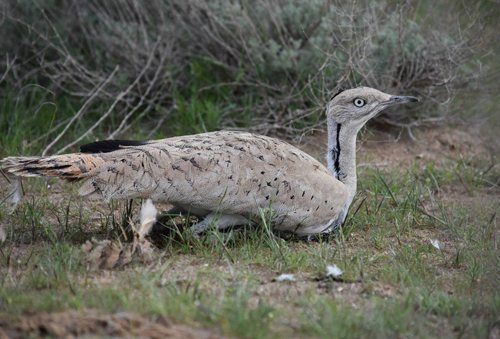 Falcon Hunting Solutions works hard on developing nurseries for breeding rare wild animals as well as constructs of hunting farms in Jizzakh and Surkhandarya regions.
Falcon Hunting Solutions prioritize the increasenumber ofrare wild animals listed in the Red List of the Republic of Uzbekistan. A great example of this would be the voluntary equipping the Institute of Zoology with the necessary equipment, covering the expenses for recordof wild animalspopulation and a recent trip to the Republic of Tajikistan to explore the possibility of exchanging / purchasingmarhur for its subsequent breeding in Djizak and Surkhandarya territories allocated to Falcon Hunting Solutions.
Falcon Hunting Solutions works hard on developing nurseries for breeding rare wild animals as well as constructs of hunting farms in Jizzakh and Surkhandarya regions.
Falcon Hunting Solutions prioritize the increasenumber ofrare wild animals listed in the Red List of the Republic of Uzbekistan. A great example of this would be the voluntary equipping the Institute of Zoology with the necessary equipment, covering the expenses for recordof wild animalspopulation and a recent trip to the Republic of Tajikistan to explore the possibility of exchanging / purchasingmarhur for its subsequent breeding in Djizak and Surkhandarya territories allocated to Falcon Hunting Solutions.
As part of its activities, Falcon Hunting Solutions has initiated the construction of a nursery in Surkhandarya region in the border area of Surkhon reserve in Kulvat gorge, where the total allocated area accounts for 2,000 hectares.
Measures are being implemented for the rational use of animals that require increased attention in preserving, restoring and increasing the number, regulating the number by using them, especially animals listed in the Red List of Uzbekistan:
* Providing gamekeepers with civilian firearms and traumatic weapons, communications equipment, vehicles, other equipment and equipment.
* Bukhara deer (Cervuselaphusbactrianus),
* Ustyurt sheep (Ovisvigneiarcal),
* Severtsov's ram (OvisammonSevertzovi),
* Bukhara mountain sheep (Ovisvigneibocharensis),
* Tien Shan sheep (Ovisammonkarelini),
* Tien Shan brown bear (Ursusarctosisabellinus), as well as other animals - Siberian mountain goat, roe deer, wild boar, pheasant.
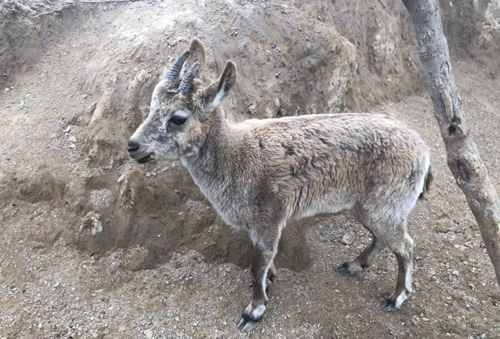
The number of animals listed in the Red List of the Republic of Uzbekistan is being counted. Population count of animals.Accounting for the number of animals is carried out according to uniform methods by special-trained people (by specialists of scientific organizations, biologists from universities and people who have undergone special training). Furthermore, protection of habitats of wild animals is conducted together with the State Committee of the Republic of Uzbekistan on ecology and environmental protection.
Falcon Hunting Solutions implements the following activities:
a) constructing nurseries for the cultivation of rare species of animals that are supposed to be released into their natural habitat to enrich itwhile some of them will be used for hunting.
b) formingareas for nurseries
c) forming the breeding stock of animals. Establishment the cooperation with neighboring countries to import breeding stock to Uzbekistan animals.
Besides there were some other activities, such as:
- The breeding nursery for Severtsovram and markhor was built in Jizzakh region (Nurata ridge);
- The breeding nursery for urial and markhor was built in Surkhandarya region;

- Joint (on a contractual basis) use of the “Djeyran” Eco-Center which is a captive complex for growing markhor, Bukhara mountain ram, Ustyurtram andsaiga.
- The breeding nursery for Tianshan sheep was built in Tashkent region (the valley of the Pskem river (Karangitugai))
- The breeding nursery for saigawas built on the Ustyurt plateau within the territory of the “Saygachy” reserve;
- Bukhara deer`s cubs were brought to Dalverzin Farm from nurseries for the breeding of Bukhara deer which are called Badai-Tugaiand Zarafshanreserves which are located in Karakalpkstan and Smarkand regions respectively
- Determining species and subspecies of mountain sheep living in Navoi region in order to restore the population and later to use them for hunting;
- Expedition to mountain sheep’s habitats in order to detemine their species on the Bukantau ridge and on the Tamdytau ridge of the Navoi region;
- Observing mountain sheep for scientific purposes in order to determine the species and subspecies;
- Development of measures for the protection, reproduction and use of sheep.
International Cooperation
During the official visit to Tajikistan «Falcon Hunting Solutions» representatives signed the scientific and technical cooperation agreement between Institute of Zoology and Parasitology under Academy of Sciences of the Republic of Tajikistan and «Falcon Hunting Solutions». The main purpose of the agreement is carrying out scientific researches, programs and projects together focused on condition assessment of valuable animal species population as well as creating secured areas and animal breeding nurseries. Besides this agreement is aimed to monitor those species in their natural environment and to develop cooperative programs focused on wildlife protection in both Uzbekistan and Tajikistan.
The parties agreed to provide mutual services, exchange information, participate in common research projects and other types of joint activities that do not contradict the laws of both countries
Furthermore, in Tashkent on 16th April the chairman of Association of trophy hunting companies AlikhonLatifi and researcher of the Institute of Zoology and Parasitology of the Republic of TajikistanMuratovRustam held presentation on topic: “Hunting and biodiversity preservation in Tajikistan”. Different participants took part in this event, namely State committee of the Republic of Uzbekistan on ecology and environmental protection, Academy of Sciences of the Republic of Uzbekistan and its Zoology Institute and also компания «FalconHuntingSolutions».
Hunting Tourism
The International Union for Conservation of Nature and Natural Resources (IUCN) has recognized the fact that rational and sustainable use of wildlife can not only be compatible with environmental principles, but also it can contribute to their realization, since the social and economic benefits derived from such use of wild animals may create incentives to protect target species and their habitats. Although the object of trophy hunting is a large number of diverse species (some of them are not endangered), some species that are rare or endangered may become an object of trophy hunting as part of environmental programs carried out in certain areas. In order to preserve and increase the population of wild animals, including those listed in the Red List, the basic principle of protection and rational use of wild animals should be implemented. In addition, the existence of populations of rare animals in specially created nurseries will reduce the risk of complete extinction of these species due to epidemics and deaths, which can be used as a genetic foundation. In addition, the existence of population of rare animals in nurseries will reduce the risk of complete extinction of these species due to the epidemics and death, which can be used as a gene pool.
About Uzbekistan
The Republic of Uzbekistan is an independent country in Central Asia which is effectively implementing reforms and which has entered the international economic community as a full member. It is a wonderful place with a rich heritage. There was a powerful trigger for the development of art and creativity in all its manifestations in the early years of independence. The process of revival of national, cultural and spiritual values as well as the entry of Uzbekistan into the international arena successfully facilitated it.
LOCATION
Uzbekistan is situated in the central part of Central Asia between major rivers Amudarya and Sirdarya with Kyzylkum Desert on the north. Turan Depression and Tian Shan mountains are located on the north-west whereas Alai-Pamir Mountains are on the south-east side. Uzbekistan is bordered by 5 countries: Kyrgyzstan, Turkmenistan, Kazakhstan, Tajikistan and Afghanistan.
WEATHER
Uzbekistan climate is extreme continental with hot and dry summer. The average summer high temperature tends to be 40 °C while the average winter low temperature ranges from from +10 to + 3 ° C
CURRENCY
All cash payments are made in soums (UZS, code 153) which is the national currency of the Republic of Uzbekistan. It was put into circulation on July 1, 1994. (1 soum equals 100 tiyins). Nowadays the following types of banknotes are in circulation - 100, 200, 500, 1000, 5000, 10 000, 50 000 and 100,000 soums. Currency exchange offices are mainly located in banks, bazaars, hotels and at the airport and are available in every city of Uzbekistan.
LANGUAGE
Uzbek language is the state language of the Republic of Uzbekistan and the language of local communication, nevertheless up to 80% of the population can speak Russian. While, in some regions, such as Samarkand and Bukhara, the indigenous population speaks Tajik.
Historical cities of Uzbekistan

Samarkand
The city of Samarkand is situated in the picturesque valley of the Zarafshan River, surrounded by the Pamir-Alai Mountains, which are in the south-east of Uzbekistan,. Samarkand is an amazing city. No matter what epithets philosophers and poets came up with for it such as the Mirror of the World, the Garden of the Soul, the Pearl of the East, the Face of the Earth, perhaps, it is impossible to convey all its beauty and richness in simple words. You can only personally enjoy all its brilliance and splendor.

Termez
Termez is located on the right side of the Amudarya river and is one of the ancient cities of Central Asia. The city evolved throughout the history on different places around the modern city, reflecting multiple cultural layers depicted in remains of historical sites. The cultural heritage that was developed from the inception of the city was completely destroyed by Genghis-Khan in 1220, after the city refused to surrender peacefully. A new city was created on the east side of the old town. Rui Gonzales de Klaviho was the ambassador sent by Castilian King Henry III to Amir Temur, he gave the best description of this new town: "entering the city, we were going so long crossing squares and crowded streets that we came home tired and angry.

Bukhara
The walls of an ancient citadel called the Arch and more than 140 monuments, narrow streets of the old city, where entire areas of ancient planning are preserved have survived to the present day. It is easy to imagine yourself as a descendant of the legendary Khoja Nasreddin. No wonder some American historian said: "If you walk the streets of the old city, it will feel like you walk through the pages of history." Bukhara is a city of poetry and fairy tales. Here, legends hover over the zigzags of street ribbons, here in the verticals of minarets - the flight of human genius, and every stone in the lace of masonry is covered with dust of eternity.

Republic of Karakalpakstan
Desert comprises more than 80% of the Karakalpakstan’s area. Thus, Karakum desert is closely adjacent to Karakalpakstan from the south-west and to Kyzylkum desert from the north-east with the Ustyurt Plateau on the north-west. Karakalpakstan also has the southern half of the Aral Sea and new Aralkum desert is being formed on its dried bottom. Despite the environmental problems, the nature of this area is truly unique. Based on the geological studies of the soil, scientists have concluded that the territory of deserts was once the bottom of a huge sea. Even nowadays people find the remains of the ancient marine animals of the Cretaceous and Cenozoic periods which is a supporting fact that there was a sea in the past.
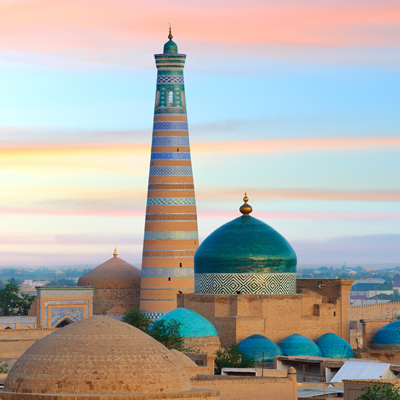
Khiva
Probably, Khiva is the most unique Uzbek city which history is inextricably connected with the history of the legendary Khorezmshah’s State with its capital in Urgench. Khiva is a very ancient city. In the 10th century Khiva is mentioned as a major trading center on the Silk Road. All the caravans had a stop there on their way to China and back. From dusk till dawn, until the gates were opened, an endless stream of moving string of camels with baggage passed them.

Kokand
But world fame came to the city in the 18th century, when it became the capital of the richest and the most developed Kokand Khanate. In the first half of the 18th century, the founder of the Kokand Khan dynasty founded the Eski-Kurgan fortress (1732) not far from modern city (the territory of the Bukhara Emirate at that time). It actually started the new Kokand, which soon got an old name that sounded like “Khuk-kand-»Cabany city» Initially, it was a small, isolated from the Bukhara emirate, but gradually it expanded geographically.
Culture and traditions of Uzbekistan
The culture of Uzbekistan is vibrant and unique. It was formed more than thousands years ago, incorporating the traditions and customs of the peoples who at various times inhabited the territory of modern Uzbekistan.
Ancient Persians, Greeks, Arabs, Chinese, Russians, and nomadic Turkic tribes contributed to Uzbek culture. The traditions are reflected in the multinational nature of Uzbekistan and are omnipresent in its music, dance, painting, applied arts, language, cuisine and clothing. Each region of Uzbekistan has its own unique shades as well, which are most clearly manifested in national dress and local dialects.
Art
Oriental masters have always been famous for their special artistic talent, which is fully manifested in the decoration of majestic palaces, mausoleums and other religious buildings. As a rule, the main motifs of Uzbek art are ornaments, patterns and calligraphy. Islamic traditions prohibit the image of people and animals, so masters began to develop more abstract directions, making them almost perfect. Later, a new type of fine Uzbek art appeared which is called miniature. It is small bright colorful pictures, covered with varnish which decorated interiors of palaces and rich houses.

Literature
The fundamental part of the development of modern Uzbek literature is the rich folklore such as literature. People composed and passed from mouth to mouth heroic epics, where characters were usually heroes who fought against oppressors and enslavers depicted in the images of evil forces. This is how the epic heroes of Uzbek folklore such as Koroghlu and Alpamysh were created. The poem “Alpamysh”, which tells about the courage of the Uzbek heroes, has survived for centuries and has become a distinguishing feauture to Oriental literature.

Music
The roots of traditional Uzbek music have ancient origins. Uzbek folk music is divided into many genres. Among them are lullabies and children's songs, ceremonial, work and everyday songs, dialogue songs, song and dance, lyrical and drawn-out. The classics of Uzbek music is makom. It is a special musical genre, which is characterized by a prolonged touching performance. They are sung by lyrical singers on poems by poets of the East (Jami, Navoi, Fuzuli, Hafiz, Uvaisi, Nadir, Mukimi, Ogahi, etc.).

Folk crafts
Applied art of Uzbekistan is a distinctive and exclusive work of folk craftsmen and artisans who pass on their skills from generation to generation. By putting a heart and a soukl in each thing, they have created unique samples of products over the centuries for example for home or home decoration, unique fabric for a festive dress or special dishes.

Pichak Production
Pchak or Pichak (Uzbeks. Pichoq - “knife”) is the national knife of Central Asian peoples such as Uzbeks and Uigurs. Traditionally it has a straight wide blade of carbon steel wedge-shaped cross-section with one-sided sharpening, sometimes with a narrow dol along the butt. A thin round handle in cross-section is attached to the level of the butt and extends slightly to the head, sometimes ends with a beak-shaped top. It can be made from horn, bone or wood and also made from colored stone. Pchack is typically worn in a wide straight leather sheath. It is distributed throughout Central Asia with minor differences in ornament and proportions.

Falconry
Traditional hunting with the use of tamed birds of prey has been known since ancient times. Falconry is its common name. These can be falcons, hawks, eagles and other birds of prey. With the development of agriculture and the emergence of weapons, its popularity has faded. Most often, people went for hunting with Northern goshawks, Saker Falcons, Gyrfalcons and Peregrine Falcons, and the last two species of birds of prey being specifically counted by many hunters. Peregrine falcon is a major representative of the falcon family, which is characterized by its incredible beauty.

Traditional cuisine
Pilaf, juicy samsa, shurpa and mouth-watering manty are not a complete list of dishes that made Uzbek cuisine famous. But now it is also recognizable due to unique recipes, which are based on lamb and all sorts of vegetables. Generously seasoned with spices and cooked in accordance with the culinary traditions of thousands of years ago, they surprise and delight people. And make those who once tasted them, to return to them again and again.

Contacts
Feedback form
News
-

Hunting and biodiversity preservation in Tajikistan
17.04.2019
- -In Tashkent on 16th April the chairman of Association of trophy hunting companies AlikhonLatifi and researcher of the Institute of Zoology and Parasitology of the Republic of TajikistanMuratovRustam held presentation on topic: “Hunting and biodiversity preservation in Tajikistan”. Different participants took part in this event, namely State committee of the Republic of Uzbekistan on ecology and environmental protection, Academy of Sciences of the Republic of Uzbekistan and its Zoology Institute and also компания «FalconHuntingSolutions».
-

Memorandum of Understanding(MOU)
12.04.2019
In 2019State committee of the Republic of Uzbekistan on ecology and environmental protection and Falcon Hunting Solutions signed Memorandum of Understanding(MOU) on cooperation in the field of biodiversity conservation and development of protected natural territories.
-

Bustards werereleased to their natural habitat.
26.03.2019
- During Navruz holidays with the assistance of State committee of the Republic of Uzbekistan on ecology and environmental protectionhoubara bustards werereleased to their natural habitat.
-

Official visit to Tajikistan
23.03.2019
- During the official visit to Tajikistan «Falcon Hunting Solutions» representatives signed the scientific and technical cooperation agreement between Institute of Zoology and Parasitology under Academy of Sciences of the Republic of Tajikistan and «Falcon Hunting Solutions». The main purpose of the agreement is carrying out scientific researches, programs and projects together focused on condition assessment of valuable animal species population as well as creating secured areas and animal breeding nurseries. Besides this agreement is aimed to monitor those species in their natural environment and to develop cooperative programs focused on wildlife protection in both Uzbekistan and Tajikistan. The parties agreed to provide mutual services, exchange information, participate in common research projects and other types of joint activities that do not contradict the laws of both countries
